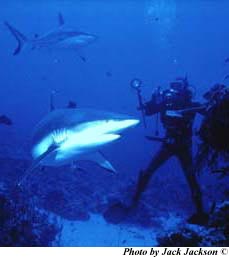 |
The International Shark Attack File investigated 65 alleged
incidents of shark-human interaction occurring worldwide in 1999.
Upon review, 58 of these incidents represented confirmed cases of
unprovoked shark attack on humans. Unprovoked attacks are defined as
incidents where an attack on a live human by a shark occurs in its
natural habitat without human provocation of the shark.
Shark-inflicted scavenge damage to already dead humans (most often
drowning victims), provoked incidents occurring in or out of the
water (usually involving divers or fishers handling sharks), and
interactions between sharks and divers in public aquaria or research
holding-pens are not considered attacks. The seven 1999 incidents
not accorded "unprovoked" status included two cases of attacks on
marine vessels, one case dismissed as being only a shark sighting,
and cases allocated to "doubtful" (2), "provoked"
(1) and "scavenge" (1) categories.
The yearly total of 58 unprovoked attacks nearly replicates the
totals recorded in 1998 (54) and 1997 (60) and the decade's yearly
average of 54. During the early part of the 1990's the number of
unprovoked shark attacks grew at a steady rate, rising from 37 in
1990 to an all-time highs of 62 in 1994 and 74 in 1995 (see
graphic). Overall, the 1990's had the highest number of attacks
(536) of any previous decade, continuing the upward trend exhibited
throughout the twentieth century (see graphic).
The number of shark attacks transpiring in a given year is
directly correlated to the amount of human time spent in the sea. As
the world population continues to upsurge and the time spent in
aquatic recreation rises, we might expect a gradual annual increase
in the number of attacks. By contrast, nearshore shark populations
are declining at a serious rate in many areas of the world as a
result of overfishing, theoretically reducing the opportunity for
shark-human interactions. However, year-to-year variability in local
economic, meteorological and oceanographic conditions also greatly
influences the odds of sharks and humans encountering one another.
As a result, short-term trends in the number of shark attacks must
be viewed with caution.
Only four fatalities were reported in 1999, roughly half the
decade's yearly average of 7. The 6.9% fatality rate was the lowest
yearly rate of the decade and well under the decade average of
12.7%. Two fatalities occurred in South Africa and single deaths
were recorded from Australia and Saudi Arabia.
More than two-thirds (67.2%, 39 attacks) of the attacks occurred
in North American waters with 37 from the United States and one each
from Mexico and the Bahamas. Elsewhere, attacks occurred in South
Africa (9), Brazil (4), New Zealand (3), and Australia (2) and Saudi
Arabia (1).
As usual, most attacks of within the United States occurred in
Florida (25) with five recorded in Hawaii; two each in California,
Georgia and South Carolina; and one in Virginia. Within Florida,
Volusia County had the most (9) shark incidents, which is largely
attributable to high aquatic recreational utilization of its
attractive waters by large numbers of Florida residents and
tourists, especially surfers. Other counties having attacks in 1999
were Brevard (4), Palm Beach (4), Martin (2), Duval (1), Escambia
(1), Franklin (1), Monroe (1), St. Johns (1), and St. Lucie (1).
Hawaiian attacks occurred on the islands of Hawaii (3), Kauai (1)
and Maui (1).
Surfers/windsurfers (24, 43% of cases with victim activity
information) and swimmers/waders (21, 38%) were the recreational
user group most often subjected to shark attack in 1999. Other
attacks involved upon divers/snorkelers (6, 11%), body surfers (1,
2%), and kayakers (1, 2%). Single attacks occurred during air/sea
disasters and water entry events.
The International Shark Attack File (ISAF) is a compilation of
all known shark attacks that is administered by the American
Elasmobranch Society, a professional organization comprised of
international workers studying sharks, skates and rays, and the
Florida Museum of Natural History. More than 3,200 individual
investigations are currently housed in the ISAF, covering the period
from mid-1500's to present. Many of the data in the ISAF originate
from the voluntary submissions of numerous cooperating scientists
who serve worldwide as regional observers. Data submitted to the
ISAF is screened, coded and computerized. Hard copy documentation,
including original notes, press clippings, photographs, audio/video
tapes, and medical/autopsy reports, is permanently archived. Data
housed in the ISAF are studied by biological researchers and
research physicians. Access to ISAF data is granted only after
careful screening on a case-by-case basis. Direct access by the
press and general public is prohibited since much data, including
medical records, is sensitive in nature and is given in confidence.
Requests for summary information and non-privileged data are made to
the ISAF director, George H. Burgess.
|




